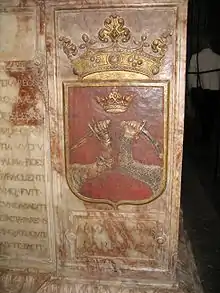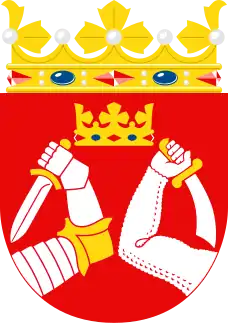Coat of arms of the Province of Karelia
The coat of arms of Karelia in Finland were first used in 1562, although the arms were probably presented at the burial of Gustav Vasa in 1560. The arms were used for the Swedish province of Karelia and they have been used continuously since then. Variations of the arms are still used in two regions of Finland: North Karelia and South Karelia, in which the North Karelian version is the original one. Present day North Karelia wasn't part of Swedish Kingdom back in 1562. Sweden gained the area from Russia after the Treaty of Stolbovo in 1617. For the most part, present day South Karelia had belonged to Sweden from 1323 onwards, since Treaty of Nöteborg.
The blazon for the arms may be translated as follows: A golden crown above two duelling arms, the left gauntleted arm holding a sword and the right mailed arm a scimitar, all silver except for golden hafts and gauntlet joint. Ducal coronet.
The two hands holding a sword and a scimitar are generally seen as symbol of Karelia's position between the Swedish and Russian realms. The coat of arms of Finland use the sword and scimitar in a similar manner.
 The Arms of Karelia on the tomb of Gustavus I (Uppsala cathedral, Sweden)
The Arms of Karelia on the tomb of Gustavus I (Uppsala cathedral, Sweden) The Arms of the historical Province of Karelia
The Arms of the historical Province of Karelia The Arms of the Finnish Region of North Karelia (the original type without the ducal coronet).
The Arms of the Finnish Region of North Karelia (the original type without the ducal coronet). The Arms of the Finnish Region of South Karelia.
The Arms of the Finnish Region of South Karelia.